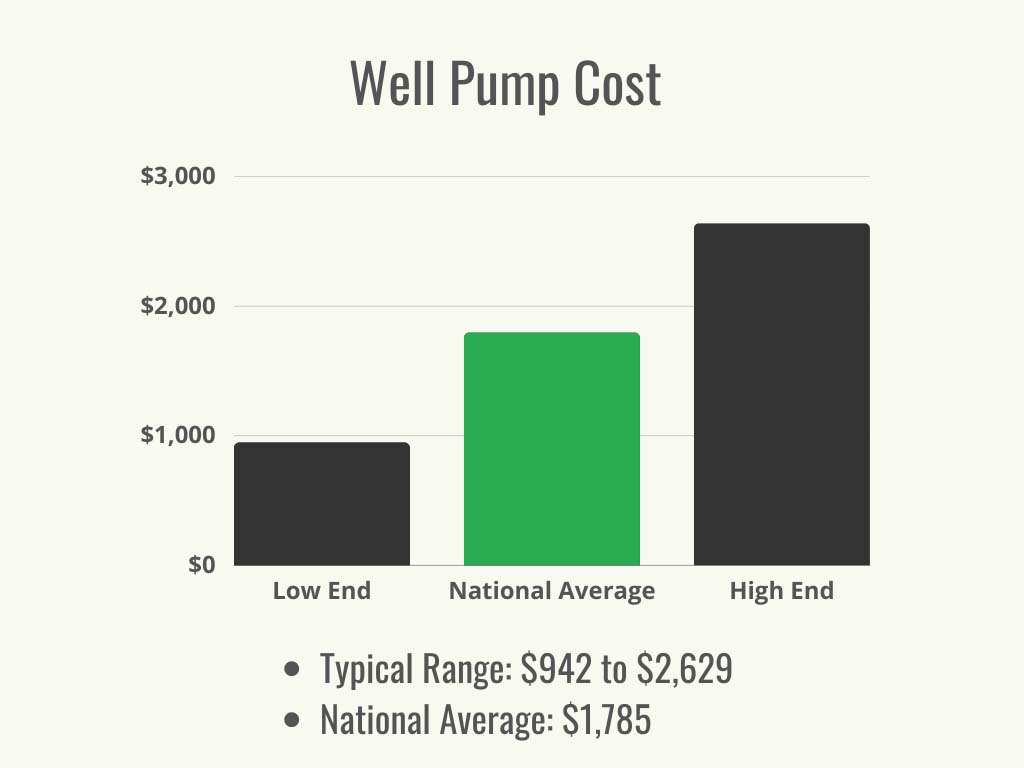

We may earn revenue from the products available on this page and participate in affiliate programs. Learn More ›
Highlights
- The typical range for well pump installation is $942 to $2,629, with a national average of $1,785.
- The main factors affecting well pump costs are well size, pump type, power, quality, labor costs, and geographic location.
- Some signs that it’s time to replace a well pump are inconsistent water pressure, a dry or low well, unusual noises, dirty water, high electric bills, spitting faucets, or extremely high water temperatures.
- It’s generally recommended that a professional perform a well pump installation or replacement, as there are a number of safety risks associated with this task.
Water is life. And well water offers clean, fresh water that is higher in minerals than most other water sources. Well water is also the most cost-effective source for delivering water to a home. But how does fresh, underground water get from the well to the faucet? Typically powered by pressure, well pumps push water from a well into storage tanks where it’s held until needed.
For a homeowner who is considering using a well as their home’s main source of water and debating whether to install a new one or replace an existing one, either by choice or necessity, the first question is usually the same: How much does a well pump cost?
According to Angi and HomeAdvisor, the average new well pump cost is $1,785, though prices range from $942 to $2,629. Several factors influence the final cost of a well pump installation, including the well size and depth, the type of pump, and the home’s geographic location.
This guide will help readers learn about new well pump price estimates, the difference between the most common types of well pumps, and signs an existing pump is in need of repair or replacement.
Factors in Calculating Well Pump Cost
How much is a new well pump? There are several factors that influence well pump cost, including the well’s size and the type of pump being installed. Such factors determine whether an installation will be under four figures or exceed an average well pump budget.
Homeowners will also want to keep in mind that local averages may be different from the national average well pump installation cost of $1,785. A home’s geographic location is another important factor that determines the final price of a well pump installation.
The following factors will help homeowners estimate the cost of a well pump replacement or new installation.
Well Size and Depth
Well size and depth have a significant influence on well pump cost. Installing a well pump in a shallow well will require less work compared to installing one in a deeper or wider well. Pumps designed for more shallow wells are typically more affordable than those designed for deeper wells.
When the cost of materials and labor is combined, installing a well pump in a shallow well will almost always be less expensive than installing one in a deep well. Shallow pumps are designed for wells less than 25 feet deep, while deep pumps can be used in wells as deep as 150 feet.
Pump Type
The type of pump chosen for an installation or replacement is the most influential factor regarding the cost to replace water pumps on a residential property. Shallow well pumps are the more affordable option, costing as little as $100. For example, jet pumps cost between $100 and $500 for shallow models, whereas deep well jet pumps cost between $675 and $745.
Jet pumps are typically replaced with submersible pumps. These models cost between $250 and $1,200. However, new pipework is typically required with deep well submersible pumps, and this can add an additional $250 to $2,500 to the budget.
Solar well pumps are costly, with a price range between $2,000 and $4,000; however, they offer substantial energy savings over time. Finally, there are hand well pumps to consider. These are much more affordable, starting at $150.
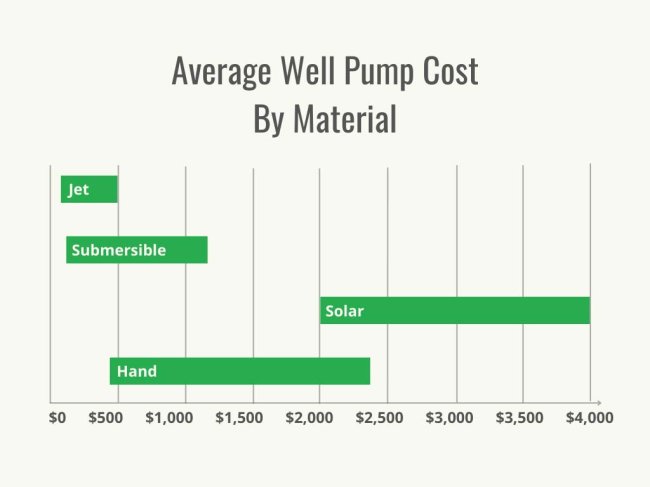
Pump Power and Quality
Homes with different water usage requirements will need pumps with different power levels. Pumps are measured using a metric acronym known as GPM, or gallons per minute. The higher a pump’s GPM, the more water it pulls. As one may suspect, pumps with higher GPMs tend to cost more.
For example, a pump with a GPM of 3 requires a ½-horsepower (hp) pump at a depth of 15 feet or a 1-hp pump at 250 feet depth. A pump with a GPM of 15 requires a 1-hp pump at a depth of 15 feet and a 1½-hp pump at 250 feet. To estimate a home’s GPM, the homeowner can add one GPM for every water fixture in the home, including toilets, faucets, showers, washers, dishwashers, and refrigerators.
Quality can also influence price. A lower-quality pump may cost less than a higher-quality pump, even if it has a motor with more horsepower. Finding the best water pump requires finding a balance between power requirements and quality while staying within budget.
Labor
Well water pump installation requires experience and knowledge. This allows contractors to charge competitive labor fees. On average, homeowners will pay between $250 and $800 for labor costs to replace a well pump. Complex projects can rack up a labor bill as high as $1,000. Generally speaking, new well pump installations are easier and may have smaller labor costs compared to costs for a replacement. If a new well is being added to the property, well drilling costs $5,500 on average.
It may help to know that an average well pump installation takes 6 hours and that a replacement also typically takes about 6 hours. The best well pump services and plumbers will be transparent about their labor costs but generally charge between $45 and $150 per hour.
Geographic Location
The average cost for pumps, materials, and labor varies across the country, affecting the overall cost. Homeowners will likely pay more for a well pump in metropolitan and suburban areas than they will in rural areas since the cost of materials and labor is typically higher. The following table shows the average well pump cost in a variety of U.S. cities.
| Location | Average Cost |
| Chicago, Illinois | $1,470 |
| Dallas, Texas | $2,100 |
| Manhattan, Kansas | $1,050 |
| Orlando, Florida | $2,590 |
| Portland, Oregon | $5,110 |
| Raleigh, North Carolina | $1,270 |
Additional Costs and Considerations
When installing water pumps and tanks, homeowners will not necessarily incur the following potential costs. However, they may still benefit from understanding how influential each one is. This can help prevent expensive surprises and ensure that a well pump installation stays on budget.
Pipework
When homeowners are switching from one type of pump to another, it’s likely that pipework will need to be added or replaced. In other scenarios, pipework may need to be replaced due to age or damage. In older homes, pipes may not be made of safe plastic materials like PVC. If there are signs of corrosion or there is a risk of lead contamination, some homeowners decide to replace pipework during a pump installation.
It can be difficult to estimate the cost of pipework when it comes to well pump replacement. The material, length, and accessibility of the pipework location all influence the cost. The average cost for pipe installation is $0.90 per foot for PEX (cross-linked polyethylene) pipe and $6.25 per foot for copper pipe.
Wiring
Similar to replacing pipework, replacing a well pump could involve updating or replacing wiring. In some scenarios, wiring can be damaged while a new pump is being installed, especially if the well is quite deep. In other instances, the wiring is outdated or beginning to show signs of wear and tear. Damaged electrical wires are dangerous at any time but especially when they are near a water source.
It’s worth noting that it’s possible to run a well pump without electricity. Depending on a homeowner’s budget or water needs, however, this isn’t always an option. In most new installations, wiring is part of the process. On average, hiring an electrician can cost anywhere from $162 to $525. The total cost will vary based on how much work is required and how complicated it is.
Pressure Tank Replacement
A well pump replacement isn’t always enough. Sometimes the system’s pressure tank is the culprit behind water issues. In many scenarios involving a combination pump or pressure tank, replacing one component and not the other can be cost-prohibitive.
In fact, many problems with a pump or well can stem from a malfunctioning tank. To test a system’s tank, homeowners can run the water from any fixture in their home. If the pump kicks on every time the water is running, it’s likely that the tank isn’t holding pressure. If a tank does need to be replaced, a homeowner can expect to pay between $800 and $3,800. The cost to replace a well pump and pressure tank together may be significantly higher.
New vs. Replacement Pump Installation
When a well pump begins to fail, it’s difficult to know right away whether a repair or a replacement will be the most cost-effective approach. It’s recommended that homeowners have a pump professional come out and inspect the system to suggest the best solution.
When there is hardware damage or small engine problems, a repair is likely the best approach; repairs tend to cost between $300 and $1,300. But when a major mechanical or engine issue is causing a pump to perform poorly or fail entirely, a total pump replacement is likely, and all the more so when a pump is nearing the end of its expected lifespan. Well pump replacement costs $1,785.
Well Pump Repairs
In some cases, only a part of the well pump will need to be replaced, not the entire system. This is almost always cheaper than the cost to replace a well pump altogether. The pump motor is a common feature to be affected by wear and tear, and it usually costs between $175 and $1,400 to repair. A well pump pressure switch is one of the least expensive replacements at $50 to $150. A booster pump can cost as little as $250 to repair or as much as $2,000, including labor. Look up “well pump repair near me” to get a sense of local repair prices.
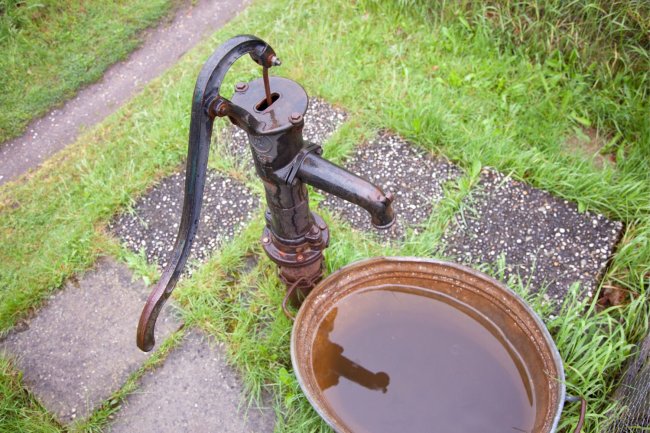
Types of Well Pumps
To understand what to look for when shopping for a well pump, homeowners will benefit from knowing the different types available. Each one offers unique benefits and functions differently from the rest. Each type of pump also has unique price points homeowners will want to be aware of when choosing the best pump for their well water system. The following are the different types of well pumps and their average costs.
| Well Pump Type | Average Cost |
| Jet pump | $100 to $745 |
| Submersible | $250 to $1,200 |
| Solar | $2,000 to $4,000 |
| Hand | $150 to $2,000 |
| Windmill | $4,200 to $19,600 |
| Constant-pressure | $2,000 to $5,000 |
Well Jet Pump
There are two types of well jet pumps: shallow well jet pumps and deep well jet pumps. The best shallow well jet pumps tend to be inexpensive and work best in wells with a depth not greater than 25 feet. On the other hand, deep well pumps are ideal for wells with a depth of over 25 feet and up to 150 feet. In addition to being less expensive than other types of pumps, jet pumps are also easier to service. However, they can be less powerful and effective than other types of well pumps.
Shallow jet pumps cost between $100 and $500, while deep well jet pumps cost between $675 and $745.
Submersible Well Pump
As evidenced by the name, these pumps are fully submersible in a well. Therefore, they dedicate much of their energy to pushing water to the top rather than pulling water from the top as jet pumps do.
Submersible pumps work great in wells that are as deep as 400 feet or as shallow as 25 feet. They are also the most preferred type for modern well systems because of their versatility, efficiency, and durability. Most well jet pumps are replaced with submersible models when they fail.
Homeowners can expect to pay between $250 and $1,200 for a submersible well pump. If pipework is needed, installation can cost an additional $250 to $2,500.
Solar Well Pump
Solar pumps don’t rely on external power sources to run, so they cost less to operate than more traditional pump options. Rather than relying on electricity, the pump has solar panels that generate the power required to move the water. This makes them a great choice for off-the-grid living or areas where power outages are common.
However, solar well pumps tend to have higher unit costs than traditional models. Homeowners interested in a solar well pump will want to budget at least $2,000 for a unit. Some higher-end solar pump models can cost up to $4,000.
Hand Well Pump
Hand pumps are available in plastic, cast-iron, and stainless steel models. They aren’t the most popular well pump options, but they work very well for off-the-grid pump installations. In addition to being less expensive than other types, hand well pumps offer the benefit of being operable regardless of a property’s utilities or weather conditions.
However, they require physical labor to pump. This may rule them out for homeowners who are physically unable to make frequent trips to pump water. However, given that they start at $150, it’s hard to find a well pump with a smaller price tag. More expensive models cost up to $2,000.
Windmill Water Pump
Windmill water pumps have a price range of $4,200 to $19,600. They may not fit into every budget, but they do offer unique benefits. A windmill water pump is more eco-friendly than an electric water pump and can help homeowners save money on their energy bills.
Windmill water pumps are ideal for areas with frequent power outages or without enough sunlight to allow for a solar-powered water pump. They’re also ideal for dual systems, serving as a backup or energy-saving option. But with the high costs of installation, windmill water pumps don’t make sense for every homeowner or property.
Constant-Pressure Pump
Constant-pressure well pumps run at several speeds as opposed to other pumps that operate at just one. The system’s pressure tank features a unique electronic controller that adjusts the pump speed as needed.
For example, instead of only kicking on when the pressure is reduced by around 20 pounds per square inch, like most other pump types, a constant-pressure pump starts to run when the pressure goes down by only 2 pounds per square inch. This ensures water pressure remains steady.
These pumps are great for homes with large families, as they can provide even water pressure no matter how many faucets, showers, or appliances are being used. Constant-pressure well pumps come with a price tag between $2,000 and $5,000.
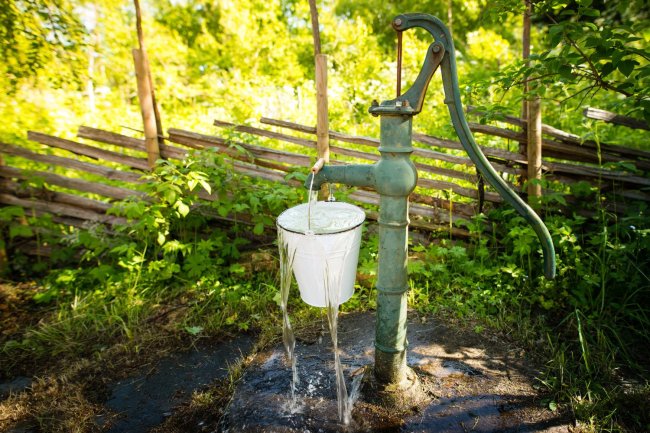
Do I Need a New Well Pump?
Well pumps have long lifespans, but over time, they can show signs that a repair or replacement is required. Homeowners will want to be on the lookout for the following symptoms of a failing well pump.
Inconsistent Water Pressure
Turning on the shower or the kitchen faucet to experience dribbles over a steady flow of water can be a frustrating experience. Homeowners noticing painfully slow water flow or inconsistent water pressure levels may have a faulty water pump to blame.
Inconsistent water pressure can indicate an improperly sized water pump. It can also be a sign that the pump is damaged or struggling to access low well water levels. And in some scenarios, inconsistent water pressure can be a side effect of an aging water pump that’s reaching the end of its lifespan.
If inconsistent water pressure is a frequent issue, putting off a repair or replacement can be catastrophic. A home’s low water pressure will only continue to decrease until showers and faucets fail to release any water at all.
Dry or Low Well
During droughts, available well water is often reduced. If this dry spell extends for a long time, a pump can have difficulty drawing enough clean water for a home.
Signs of a dry or low well include dirty, muddy, or cloudy water; water that tastes or smells like rotten eggs; and low water pressure. Sputtering water is another sign of a dry or low well. All of these signs indicate a potential need for a water pump replacement. Homeowners will not want to put this off, as a low or dry well means a pump will suck in air instead of water, causing sputtering and potential damage to the unit. Additionally, muddy water can accumulate inside a pump and prematurely wear on the inner components.
Unusual Noises
Unusual noises that seem to be coming from a well pump are a common sign of potential failure. It’s important to note that the noises are typically coming from the pressure tank, where the water is stored, and not the pump itself.
Pressure tanks contain a bladder full of air. If the air is suddenly lost or leaks out into the tank, a constant or rapid clicking noise is often heard.
This can trigger the pump to start and stop more than normal, causing premature wear and tear on the water pump motor. Ignoring a pump that’s making unusual noises can drastically reduce its life expectancy.
Dirty Water
When water has a metallic taste or smell, it’s usually due to harmless minerals in the well (though this can be an issue in homes with older plumbing that includes lead pipes). However, if the water is coming out with dirt, sand, or sediment, this typically indicates an issue with the pump.
If a well’s pump is too large, it may bring up silt and dirt from the bottom. To fix this, a well pump specialist may recommend replacing the pump with a smaller model.
A pump’s size isn’t the only potential cause of dirty water. Over time, pumps can become clogged with sediment and debris, which can also lead to dirty water. No matter the cause, it’s recommended that homeowners avoid consuming dirty water from a well until the cause has been determined and remedied. It’s also worth looking into the best well water filtration systems.
Increased Electric Costs
When an electricity bill significantly increases for no obvious reason, a well pump can be to blame. Even though pumps use a lot of electricity, they don’t run all day. In fact, they typically run for only a short period each day. A leaking or damaged pump may run continuously or much longer than usual, which can cause a drastic uptick in a home’s electricity usage.
When a homeowner notices a spike in their electricity bill, it may be time to replace the well pump. While it’s an additional up-front cost, it can actually help save money in the long run.
Spitting Faucets
Spitting faucets are often the result of a pressure change. When air is trapped somewhere inside a home’s plumbing, it can create a spitting effect at the faucet. Tapping or banging can also be a sign of air inside a home’s pipes and occurs when a pump is not able to pull in enough water.
These are signs of a potentially failing water pump system and need immediate attention. Not only can the problem become messy, but it can signal that a well pump is nearing the end of its lifespan and needs to be replaced before it fails entirely.
Extremely Hot Water Temperature
Scalding-hot water during a showering session can signal an issue with a well pump system’s pressure tank. If a homeowner notices that flushing a toilet causes running water in the shower or at the kitchen sink to jump up suddenly in temperature, it’s a symptom worth paying attention to.
Some homes are built with two- or three-handle tub and shower valves. Unlike new, single-handle valves, these older valves don’t have pressure-balancing spools. As more water enters the home, a drop in pressure from the tank can allow more hot water through the pipes than cold, causing a sudden temperature increase that can be not only annoying but also dangerous.
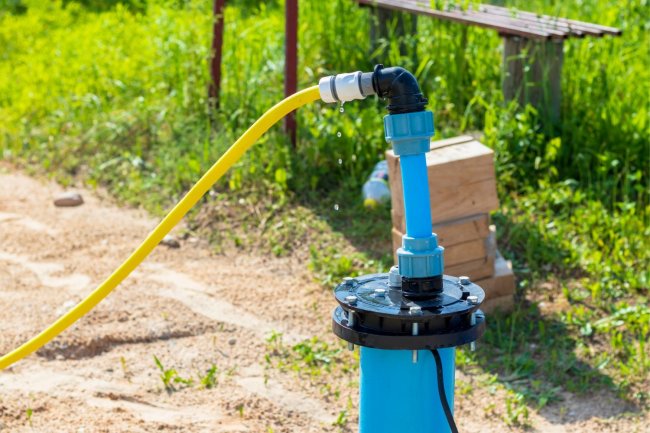
Well Pump Installation: DIY vs. Hiring a Professional
Installing a water pump for house well systems can be expensive, so it’s not surprising when a homeowner wants to tackle the installation on their own to save on labor costs. However, that doesn’t mean this is a project a homeowner will want to tackle. While a homeowner could technically look up how to replace a well pump and attempt to do the job themselves, professional well pump installers don’t usually recommend DIY well pump installation unless the homeowner has the knowledge, experience, and resources to complete the job accurately and safely.
Well pump installation is complex and labor intensive. Depending on whether the pump is submersible or aboveground, replacing it could take up to 4 hours. It might take even longer if it’s a submersible type, due to accessibility issues.
On average, it takes two people to pull a pump out from below the ground and then replace it with a new unit. This is because it takes one person to stand just above the well to remove the pump from its casing and another person to ensure that the water line stays intact.
It can also be a dangerous project. A well pump could be submerged in a well as deep as 25 to 400 feet from ground level. Additionally, most well pumps have a ground wire that can make the job extremely dangerous if the installer has minimal experience working with electricity.
While it is possible for a homeowner to install a new well pump on their own, the risks involved and the complexity of the task make hiring a trustworthy and skilled professional the safer and more cost-efficient option.
How to Save Money on Well Pump Cost
In some cases, installing a well can save money in the long run. However, the initial cost of well pump repair or replacement can be overwhelming. While it can be difficult to shave costs off an installation, there are several ways a homeowner can get the most use out of their investment. Below are some practical money-saving tips for a well pump installation.
- Seek multiple quotes from several professionals. This can ensure the most qualified contractor is hired for the job. Focus on the value a quote offers rather than the price alone.
- Consider repair over replacement. This won’t always be an option, but in some scenarios, repairing a well pump component can make more financial sense than replacing the whole unit. Similarly, reusing components like wire or pipes from an initial installation in a new installation can cut down on material costs without compromising quality.
- Keep a record of any issues. Diagnosing a problematic pump can be time-consuming. The more information you can provide to a contractor, the faster and less expensive a diagnosis can be.
- Install components that boost longevity. Speak to your contractor about installing a torque arrestor and a wire guard. Both help prevent premature aging and failure in a pump and are not always included in an installation.
Questions to Ask About Well Pump Installation
Finding a contractor for a well pump installation is no easy task. It can take time and effort to find a professional with the right experience at a fair price point. To help speed up the selection process, a homeowner is advised to ask plenty of questions, including the following.
- How many years of experience do you have?
- Are you licensed and insured?
- How many wells have you drilled, and how many pumps have you installed?
- What quality tests do you perform?
- What type of pump do you recommend for my property?
- Do I need a new pump, or is a repair possible?
- When can the installation start?
- How long will the installation take?
- Will you perform the installation, or do you use subcontractors?
- How are your employees trained?
- Is there anything I need to do to prepare my home for installation?
- Can I drink my water until the installation, or is it unsanitary? And are showers and baths safe?
- Do you offer any warranties on your pumps or services?
- Do you offer well pump service and repair or just installation?
- What type of maintenance do you recommend?
FAQs
Installing a well pump can provide a home with a cost-effective and clean water source that can operate safely for years. With an average installation cost of $1,777, it’s an investment project that can pay for itself over time.
Wary homeowners can reference the following FAQs for clarity and transparency regarding any possible concerns they may have about well pump installation.
Q. How long does a well pump last?
A newly installed well pump will last for 15 years on average. This lifespan can be affected by several factors, including the frequency of the pump’s duty cycle, the quality of the pump’s motor, levels of sediment present in the well water, and the depth of the property’s water table.
Q. Can I replace a well pump by myself?
While it’s possible for a homeowner to replace a well pump by themselves, it’s not recommended. Removal of an old well pump is a two-person job, and seeking the help of a professional is recommended in order to ensure the proper replacement well pump is chosen and installed in a way that preserves its longevity.
Q. How often should a well pump be serviced?
An annual maintenance test should be conducted on any privately owned well. This typically includes a bacterial test and will need to be done in conjunction with regular maintenance and precautions, such as periodically checking the pump’s well cap and paying close attention to any changes in the well, its surrounding area, and the quality of its water.
Q. Is it worth it to get a new well pump?
If a well pump has reached the end of its 15-year lifespan, getting a new one installed is a more economical choice in the long run than paying for frequent repairs. A new well pump will also ensure optimal performance and efficiency, which is not a guarantee with an out-of-date well pump that may eventually require constant servicing.
Q. How do I know if my well pump is broken?
A broken well pump cannot go unnoticed for long. There are some tell-tale signs that a home’s well pump needs service or replacement, including loud noises, inconsistent pressure from the pump, dirty water, air coming through faucets, and a spike in a home’s electrical bill.
Q. How long does it take to replace a well pump?
If the pump is installed professionally, between a half and a full day’s work is required to replace it. Several factors including location and type of the well pump as well as the depth of the pump being replaced will all determine the amount of time needed for the project.
Sources: Angi (1 and 2), HomeAdvisor, HomeGuide, Thumbtack
